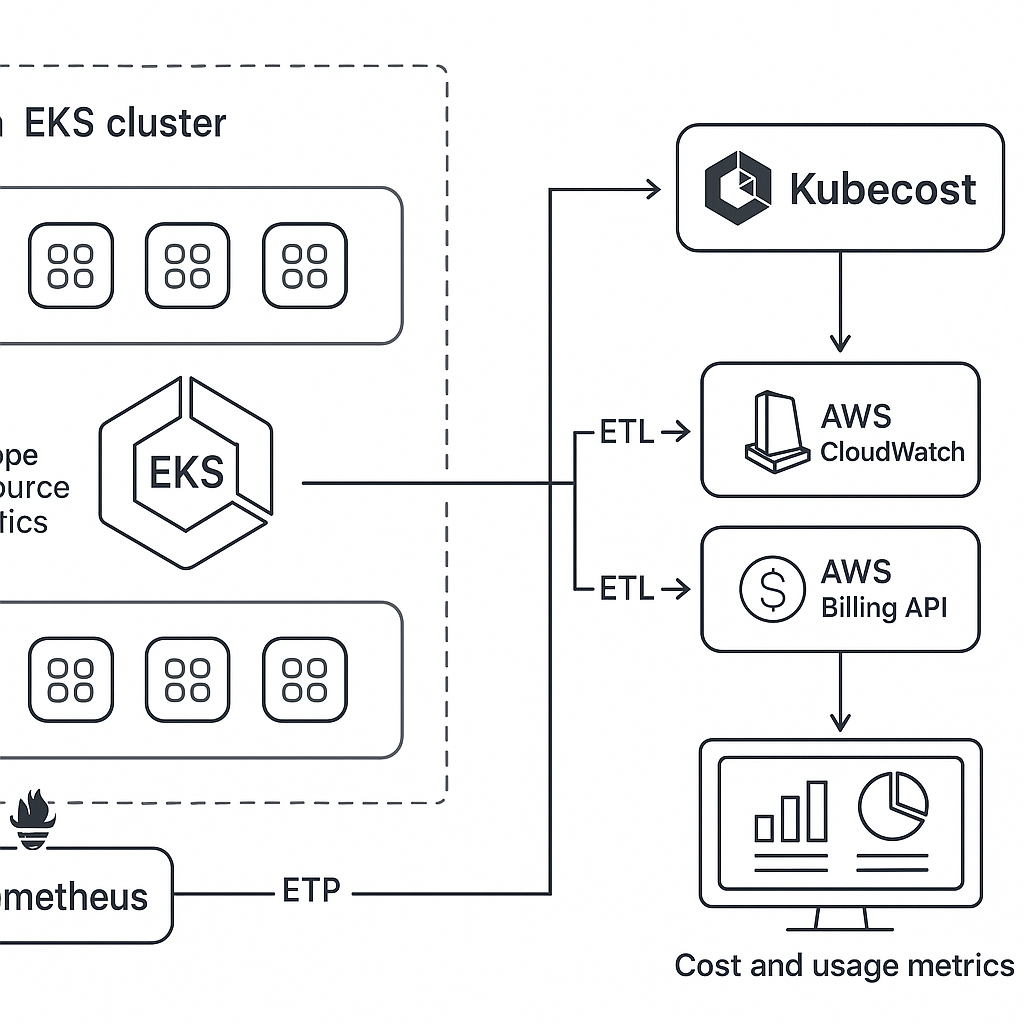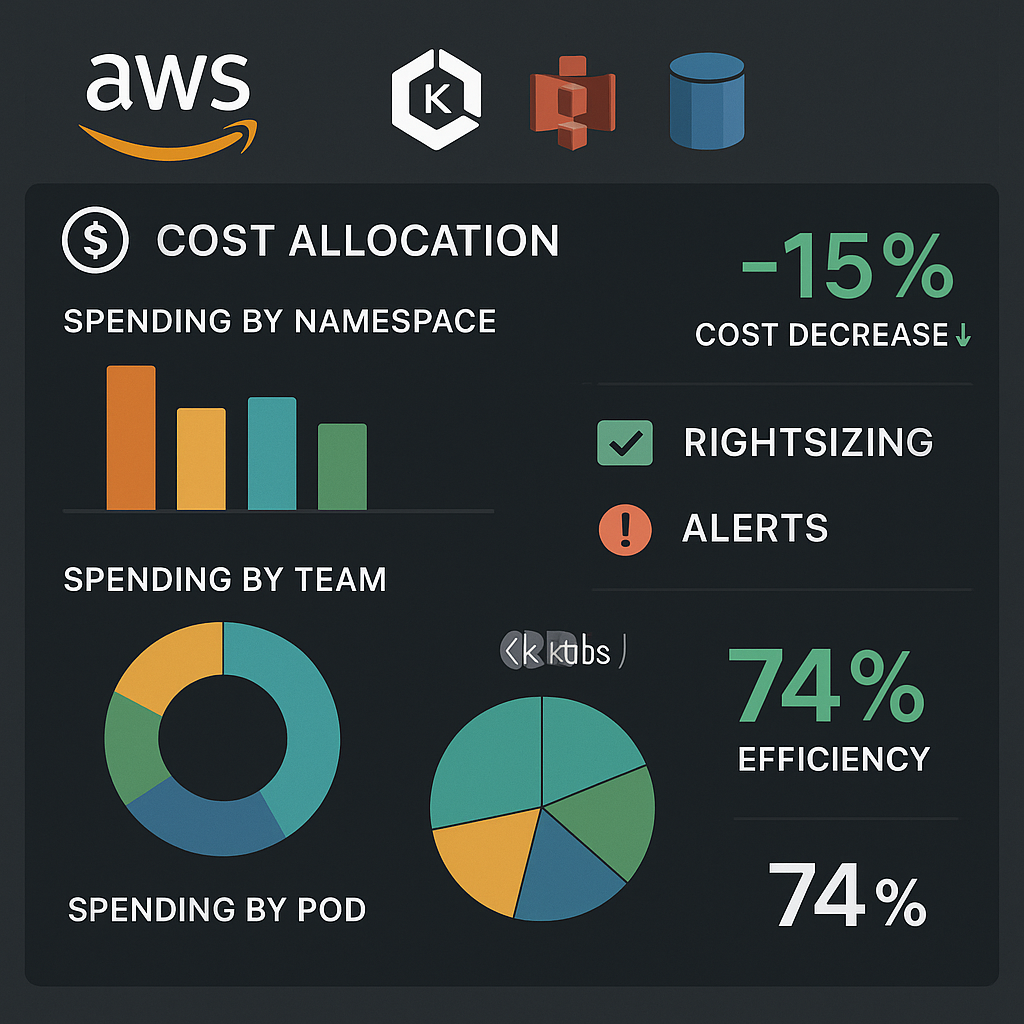Understanding Kubecost metrics for AWS cloud cost savings
Do you know exactly how much your Kubernetes clusters are costing you on AWS? Most organizations don’t—and they’re likely overspending by 30-50% on their cloud infrastructure. Kubecost changes this by providing deep visibility into your Kubernetes spending through comprehensive metrics collection and analysis.
How Kubecost collects metrics in AWS environments
Kubecost employs a sophisticated metrics collection system that integrates seamlessly with your AWS Kubernetes clusters. The platform operates through several key technical processes:

Data collection pipeline
-
In-cluster metrics: Kubecost scrapes detailed CPU, memory, storage, and network usage metrics at the pod, namespace, and cluster levels using Prometheus.
-
AWS integration: The platform connects directly with AWS CloudWatch and AWS Billing APIs to gather essential cloud service and cost data.
-
ETL process: Once collected, metrics undergo an extraction, transformation, and loading process that makes raw data actionable for cost optimization decisions.
According to AWS documentation, Kubecost integrates with Cost and Usage Reports to provide a comprehensive view of both in-cluster and out-of-cluster costs in a unified dashboard, which eliminates visibility gaps across your infrastructure.
Key metrics monitored by Kubecost
Kubecost tracks several critical metrics categories that provide a complete picture of your AWS Kubernetes spending:
Resource utilization metrics
- Compute resources: CPU and memory usage by pod, deployment, and namespace
- Storage utilization: Persistent volume claims and storage class consumption
- Network traffic: Inbound and outbound data transfer costs between pods and AWS services
These utilization metrics are crucial because they serve as the foundation for identifying resource waste. For instance, a development team might be running containers with 4GB of memory allocated when actual usage peaks at only 1.5GB—a perfect opportunity for rightsizing.
Cost allocation metrics
- Namespace-level costs: Spending by logical application groups
- Label-based attribution: Costs organized by team, project, or business unit using Kubernetes labels
- Pod-level expenses: Granular spending tracked down to individual pods and containers
The power of these allocation metrics lies in their ability to create accountability. When engineering teams can see exactly how much their services cost, they’re more likely to optimize their resource requests and architecture decisions.
AWS-specific metrics
- EKS cluster costs: Managed Kubernetes service fees
- Out-of-cluster services: S3, RDS, and other AWS service costs integrated with Kubernetes workloads
- Discount program application: Tracking of Savings Plans and Reserved Instance coverage
This holistic view prevents the common problem of optimizing Kubernetes workloads in isolation while missing opportunities to reduce costs in connected AWS services.
How metrics drive cost optimization
The real value of Kubecost lies in how it transforms metrics into actionable cost-saving opportunities:
Rightsizing recommendations
Kubecost analyzes historical resource utilization patterns to identify over-provisioned workloads. By comparing actual usage against requested resources, it can recommend right-sized configurations that eliminate waste without compromising performance.
For example, Hykell customers have seen that dynamic request sizing based on Kubecost metrics can reduce cluster costs by up to 40% by eliminating unnecessary resource padding. Think of it as tailoring a custom suit rather than buying one-size-fits-all—you get exactly what you need without paying for excess.
Idle resource detection
The platform flags unused or underutilized resources, including:
- Empty nodes in EKS clusters
- Idle pods consuming resources
- Unattached EBS volumes
- Abandoned persistent volume claims
These insights allow AWS administrators to reclaim wasted spending that would otherwise go unnoticed. It’s like finding money in forgotten coat pockets—except in this case, the forgotten resources might be costing you thousands of dollars monthly.
Storage class optimization
Kubecost provides detailed metrics on storage consumption by class, allowing teams to make informed decisions about appropriate storage types. For instance, it might recommend switching from gp2 to gp3 EBS volumes for better price-performance or identify opportunities to move infrequently accessed data to more cost-effective storage tiers.
According to AWS’s prescriptive guidance, optimizing storage classes alone can yield significant savings, especially in data-intensive applications where storage costs can exceed compute expenses.
Setting up effective alerts and reports
Metrics are most valuable when they trigger timely action. Kubecost enables proactive cost management through:
Budget alerts
Configure spending thresholds at the namespace, cluster, or team level. When costs approach or exceed defined limits, Kubecost can send alerts via Slack, email, or other notification channels.
These alerts act as an early warning system, preventing the all-too-common end-of-month surprise when cloud bills arrive. Instead of reactive cost cutting, teams can address issues before they become expensive problems.
Recurring reports
Schedule daily, weekly, or monthly cost reports that highlight:
- Spending trends
- Largest cost drivers
- Potential savings opportunities
- Resource efficiency metrics
These automated reports save hours of manual analysis and ensure cost optimization remains a continuous process rather than an occasional fire drill.
Custom dashboards
Create tailored Grafana dashboards that visualize the metrics most relevant to your organization’s cost optimization goals.
As the Kubecost features page explains, these dashboards can be customized for different stakeholders—engineering teams might focus on resource efficiency metrics, while finance departments might prefer budget adherence and forecasting views.

Real-world impact of metrics-driven optimization
Organizations using Kubecost to monitor and optimize their AWS Kubernetes environments typically see dramatic results:
- 30-50% reduction in cluster costs through automated resource right-sizing
- Elimination of unused resources that can account for up to 15% of cloud spending
- Improved budget forecasting with accurate allocation of costs to teams and projects
One enterprise customer identified through Kubecost metrics that a single development namespace was consuming disproportionate resources due to inefficient container configurations. By addressing these issues, they achieved a 40% cost reduction over six months, as noted in Apptio’s case studies.
Integrating Kubecost with broader AWS cost optimization
While Kubecost provides powerful Kubernetes-specific insights, maximum cost savings come from integrating with broader AWS optimization strategies. Hykell’s automated cloud cost optimization services complement Kubecost by extending similar visibility and optimization to your entire AWS infrastructure.
This integrated approach is crucial because Kubernetes is just one part of your AWS environment. True cost efficiency requires optimizing your entire infrastructure stack—from compute instances to database services to storage solutions.
By combining Kubecost metrics with comprehensive AWS cost management, organizations can achieve the promised 40% reduction in cloud spending while maintaining or improving performance. This holistic approach addresses not just container efficiency but also instance families, discount programs, and architectural improvements.
Getting started with Kubecost metrics on AWS
Ready to gain control over your Kubernetes costs? Here’s how to begin:
- Install Kubecost in your EKS clusters using Helm
- Configure AWS integration with appropriate IAM permissions
- Allow 24-48 hours for initial data collection and analysis
- Review your first cost allocation report to identify quick wins
- Implement recommended optimizations and track savings over time
Don’t let unnecessary Kubernetes spending drain your AWS budget. With proper metrics collection and analysis through Kubecost, you can achieve significant savings while maintaining performance for your containerized workloads.
For comprehensive cloud cost optimization that extends beyond Kubernetes, consider Hykell’s automated cloud cost optimization services to maximize your AWS savings across your entire infrastructure.
